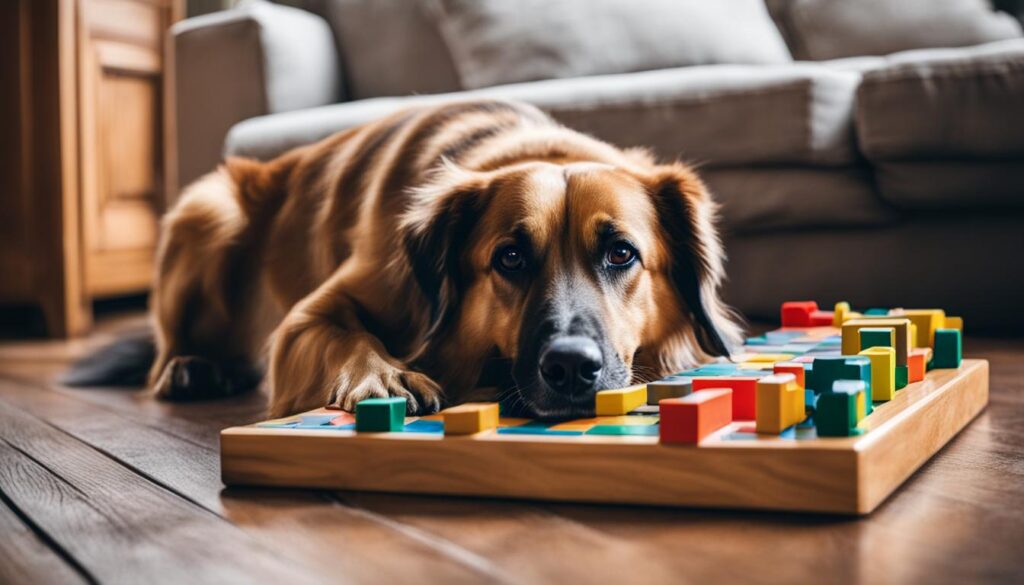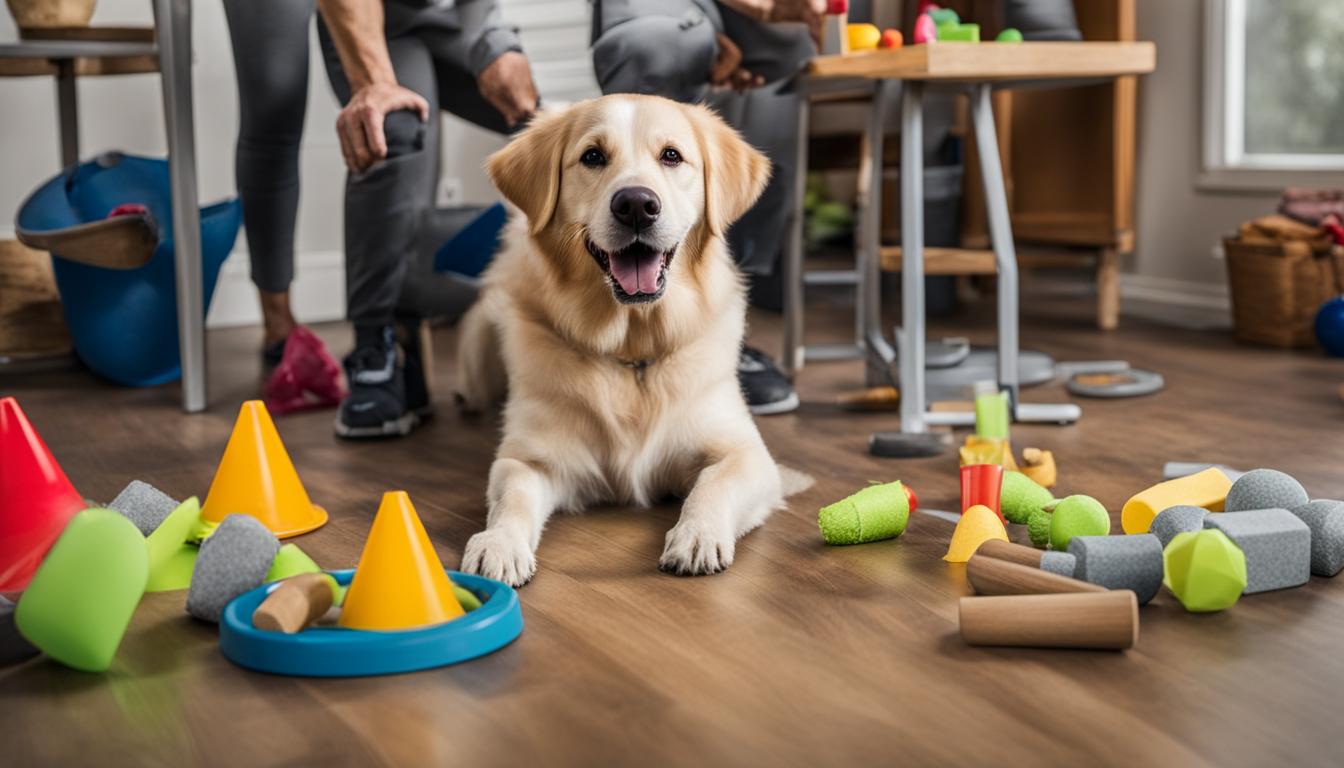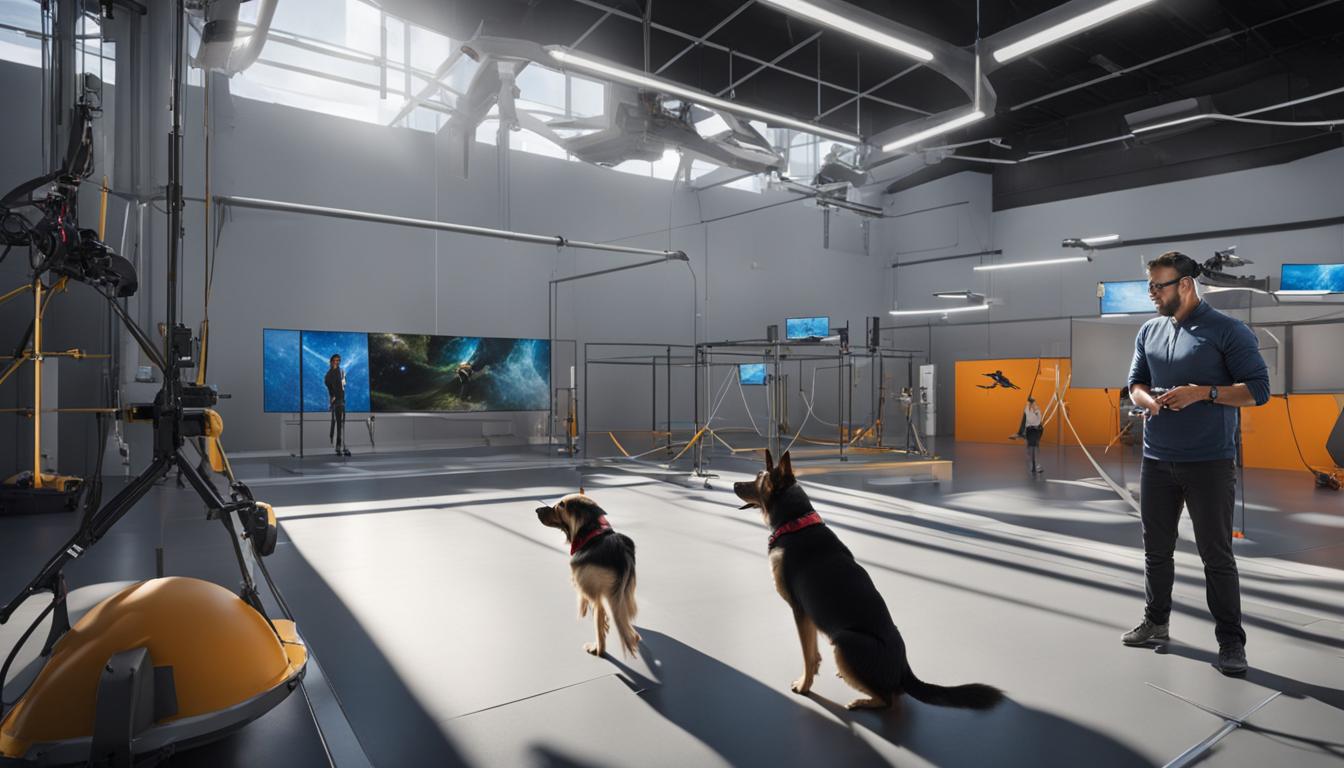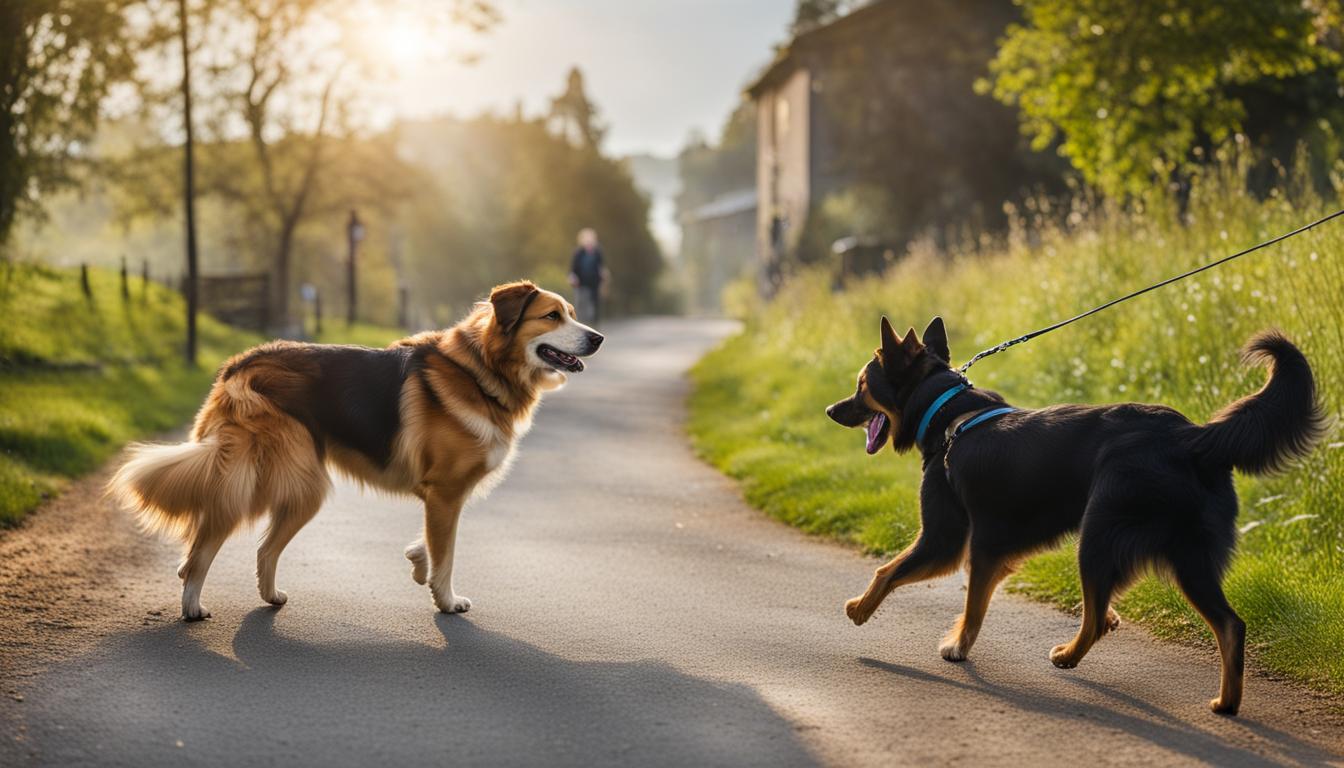Training older dogs can be a delightful journey filled with rewards, but it also comes with its fair share of challenges. Many misconceptions surround the training of senior dogs, leading to confusion and frustration for dog owners. However, with the right approach and understanding, you can overcome these age-related training issues and build a strong bond with your furry friend.
It’s important to debunk the myths surrounding training older dogs and recognize that positive reinforcement methods are not only effective but also safer for seniors, including those with aggression issues. Remember, dogs don’t need dominance-based training but rather effective leadership and positive reinforcement to thrive. By adopting the right mindset and techniques, you can pave the way for successful training sessions.
Key Takeaways:
- Training older dogs can be challenging but rewarding.
- Positive reinforcement methods are effective and safer for seniors.
- Debunk myths surrounding training older dogs.
- Focus on effective leadership and building a strong bond.
- Adapt training techniques to cater to cognitive and physical limitations.
Adjusting Training Techniques for Older Dogs
As dogs age, their training needs may change due to cognitive and physical limitations. Adjusting training techniques for older dogs is essential to ensure their continued development and well-being. Cognitive training plays a crucial role in stimulating their minds and preventing cognitive decline. Behavioral training, on the other hand, focuses on managing existing behavior issues and reinforcing positive behaviors.

Older dogs may face physical limitations that affect their ability to perform certain tasks or participate in rigorous activities. It is important to consider these limitations and adapt training methods accordingly. For example, if a dog has joint problems, low-impact exercises such as swimming or gentle walks may be more suitable than high-impact activities like jumping or running.
Remember, adjusting training techniques for older dogs is not about lowering expectations but rather finding ways to accommodate their changing needs and abilities.
Examples of Adjusted Training Techniques:
- Implement shorter training sessions to account for decreased stamina and focus.
- Break down training tasks into smaller steps to make them more manageable.
- Use positive reinforcement, such as treats and praise, to motivate and reward desired behaviors.
- Provide mental stimulation through interactive toys and puzzles to keep their minds sharp.
- Consider using alternative methods, such as clicker training, which can be effective for older dogs.
By adjusting training techniques to meet the specific needs and limitations of older dogs, we can ensure that their training is effective, enjoyable, and safe. Remember, every dog is unique, and it is important to tailor the training approach to their individual circumstances and personality.
| Training Technique | Benefits |
|---|---|
| Cognitive Training | Stimulates mental activity, prevents cognitive decline |
| Behavioral Training | Manages behavior issues, reinforces positive behaviors |
| Shorter Training Sessions | Accounts for decreased stamina and focus |
| Breaking Down Training Tasks | Makes tasks more manageable |
| Positive Reinforcement | Motivates and rewards desired behaviors |
Engaging Older Dogs in Training
Engaging older dogs in training can be a fun and rewarding experience. As our furry companions age, it’s important to adapt our training methods to meet their changing needs. By incorporating strategies that keep them motivated and maintaining consistency in our training approach, we can ensure that older dogs continue to learn and thrive.
Short and Enjoyable Training Sessions
One key aspect of engaging older dogs in training is to keep the sessions short and enjoyable. Unlike younger dogs, seniors may have limitations in their physical stamina and attention span. By keeping the training sessions brief, we can prevent frustration and fatigue, allowing our older dogs to stay focused and engaged. Remember, it’s quality over quantity.
You can make training sessions enjoyable by incorporating games, rewards, and positive reinforcement. Older dogs may have a wealth of life experience, and it’s important to tap into their natural instincts and abilities. For example, if your dog loves to sniff, you can incorporate scent-based games into their training routine. This not only keeps them engaged but also stimulates their minds.
Maintaining Training Consistency
Consistency is crucial when training older dogs. While they may take longer to learn new behaviors, regular practice and reinforcement are key to their success. Make sure to establish a consistent training schedule and stick to it. This helps older dogs understand what is expected of them and builds their confidence in the training process.
Consistency also applies to the commands and cues we use. It’s important to use the same words or signals consistently to avoid confusion. Older dogs may have already learned certain commands, so it’s essential to reinforce those behaviors and avoid any inconsistencies that may cause them to become unsure or anxious.
Additionally, maintaining consistency in our own behavior and expectations is important. Older dogs may have some age-related quirks or limitations, and it’s important to be patient and understanding. Recognize that their abilities may change over time, and be flexible in adapting your training methods to meet their individual needs.
| Benefits of Engaging Older Dogs in Training | Methods to Keep Older Dogs Engaged |
|---|---|
| 1. Mental stimulation | 1. Incorporating games and interactive toys |
| 2. Bonding and building trust | 2. Using positive reinforcement |
| 3. Preventing cognitive decline | 3. Introducing new challenges and puzzles |
| 4. Maintaining their skills and abilities | 4. Adapting training methods to their changing needs |
Engaging older dogs in training is not only beneficial for their overall well-being but also strengthens the bond between dog and owner. Through short and enjoyable training sessions, incorporating games and rewards, and maintaining consistency in our training approach, we can help our senior pups stay active, mentally stimulated, and continue to learn new skills. Remember, age is just a number, and it’s never too late to engage older dogs in training!
Training Older Rescue Dogs
Training older rescue dogs can be a gratifying and transformative experience for both the dog and the owner. These dogs often come with unique challenges, such as previous traumas or lack of socialization, which require patience, understanding, and reinforcement. By providing the necessary support and consistent training, you can help these dogs overcome their past and build a positive future.
When training older rescue dogs, it’s crucial to establish trust and create a safe environment. These dogs may have experienced neglect or abuse in the past, so it’s important to approach training with compassion and empathy. Positive reinforcement techniques, such as rewarding desired behaviors with treats or praise, can help build trust and confidence in these dogs.
Reinforcing training in aging dogs is essential to ensure that they continue to follow commands and behave appropriately in different situations. Regular training sessions and consistency are key. It’s important to remember that older dogs may take longer to learn new commands or behaviors, so patience is essential. By reinforcing training regularly, you can help older rescue dogs maintain their skills and continue to thrive.
Training older rescue dogs requires patience, understanding, and reinforcement. By providing support and consistent training, you can help these dogs overcome their past and build a positive future.
Table: Reinforcement Techniques for Older Rescue Dogs
| Reinforcement Technique | Description |
|---|---|
| Positive Reinforcement | Rewarding desired behaviors with treats, praise, or toys to reinforce positive associations and build trust. |
| Consistency | Maintaining a regular training schedule and using consistent commands and cues to reinforce training. |
| Patience | Understanding that older rescue dogs may take longer to learn new behaviors and being patient throughout the training process. |
| Empathy | Approaching training with compassion and empathy, considering the dog’s previous experiences and providing a safe environment. |
Training older rescue dogs is not without its challenges, but the rewards far outweigh the difficulties. By investing time, patience, and love into their training, you can help these dogs overcome their past and provide them with a bright future filled with trust, companionship, and happiness.

Common Dog Training Myths
When it comes to dog training, there are several common myths and misconceptions that can hinder the progress of both owners and their furry friends. It’s important to debunk these myths and separate fact from fiction to ensure effective and humane training methods. Let’s explore some of the most prevalent misconceptions about dog training:
The Myth of Dominance
One of the biggest myths about dog training is the belief that dominance-based methods are necessary to establish control and respect. However, this concept is widely misunderstood. Dogs do not need to be dominated; instead, they thrive in environments where they feel safe, loved, and understood. Positive reinforcement techniques, such as rewards and praise, are not only more effective but also create a stronger bond between you and your dog.
The Food Bribery Myth
Another common misconception is that using food during training is equivalent to bribery. In reality, food can be a powerful motivator that helps shape desired behaviors. By pairing treats with specific commands, you can create positive associations in your dog’s mind and reinforce their obedience. Over time, as your dog becomes more proficient in their training, you can gradually decrease the use of treats and rely more on verbal praise and physical affection.
“Training a dog with food is like building a relationship on a foundation of trust and positive experiences.” – Jane Smith, Professional Dog Trainer
The “Red Zone” Dog Myth
There is a common misconception that positive reinforcement training methods don’t work on “red zone” dogs – those with severe aggression or behavioral issues. However, this couldn’t be further from the truth. Positive training techniques can be incredibly effective in rehabilitating and modifying behavior in dogs with aggression problems. It’s important to consult with a professional dog trainer who specializes in behavior modification to develop a tailored training plan for your dog.
| Myth | Reality |
|---|---|
| Dominance-based training is necessary for control | Positive reinforcement creates a stronger bond and respect |
| Using food in training is bribery | Food is a powerful motivator and positive training tool |
| Positive methods don’t work on “red zone” dogs | Positive techniques can be effective for behavioral rehabilitation |
It’s essential to educate yourself on effective and humane training methods to ensure the well-being and happiness of your furry companion. By dispelling these common myths, you can create a positive and rewarding training experience that strengthens the bond between you and your dog.
Conclusion
Training older dogs may seem challenging at first, but with the right approach, it can be a rewarding journey that strengthens your bond with your furry companion. By debunking myths and misconceptions, adjusting your training techniques to suit their needs, and maintaining consistency, you can help your senior pup thrive and continue learning throughout their life.
Remember, training is a lifelong process that requires patience, understanding, and positive reinforcement. It’s never too late to start training or to continue teaching your dog new skills. Whether you have a young puppy or an older rescue dog, training can make a significant difference in their behavior and overall well-being.
So, don’t get discouraged by age or preconceived notions. Embrace the opportunity to train your older dog and enjoy the journey together. Through training, you can build a strong and trusting relationship, ensuring a happy and fulfilling life for both you and your canine companion.
FAQ
Are positive training methods effective for older dogs?
Yes, positive reinforcement methods are not only effective but also safer for older dogs, especially those with aggression issues. Dogs don’t need dominance-based training, but rather effective leadership and positive reinforcement to build a strong bond and trust.
What adjustments should be made when training older dogs?
When training older dogs, it’s important to consider their cognitive and physical limitations. Cognitive training can help stimulate their minds and prevent decline, while behavioral training should focus on managing existing behavior issues and reinforcing positive behaviors. Training methods should also be adapted to accommodate their changing abilities.
How should training sessions be approached with older dogs?
Training sessions with older dogs should be kept short and enjoyable to prevent frustration or fatigue. Consistency in training is crucial, as older dogs may take longer to learn new behaviors. Regular practice and positive reinforcement will help keep them engaged and motivated.
What should I keep in mind when training older rescue dogs?
Patience and understanding are key when working with older rescue dogs, as they may have previous experiences or trauma. These dogs may require additional time and support to build trust. Reinforcing training is essential to ensure they continue to follow commands and behave appropriately.
Are there any myths about training older dogs that need to be debunked?
Yes, there are several myths surrounding training older dogs. One common myth is the belief that dogs only respect leaders who assert dominance. The concept of dominance in dog training is widely misunderstood, and effective leadership can be established through positive reinforcement and consistent training. Another myth is that training a dog with food is bribery. In reality, food can be a powerful motivator and can help modify behavior and build trust.
Is it too late to start training an older dog?
It’s never too early or too late to start training a dog. Puppies can begin learning basic commands and behaviors from the moment they come home, while older dogs can continue to learn and adapt throughout their lives. Training should be an ongoing process that includes socialization, mental stimulation, and teaching new behaviors.
What are some common dog training myths?
Some common dog training myths include the belief that there is only one way to train a dog or that positive training methods don’t work on “red zone” dogs. These myths often stem from a misunderstanding of dog behavior and can prevent owners from using effective and humane training techniques.
What is the importance of training older dogs?
Training older dogs is crucial for maintaining their mental and physical well-being, as well as enhancing the bond between a dog and their owner. It allows them to continue learning, adapting, and behaving appropriately in different situations, even as they age.





